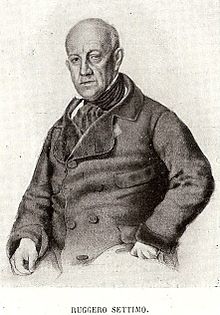Ruggero Settimo
Ruggero Settimo (born May 19, 1778 in Palermo , † May 12, 1863 in Malta ) was a Sicilian prince ( Principe di Fitalia ) and minister as well as an Italian patriot and politician .
Life
Settimo had entered the Naval Academy in Naples in 1791 and received various commands in the Bourbon fleet after completing his training . In line with his liberal sentiments, he advocated the introduction of a constitution, which he had worked on drafting. After their announcement he became Minister of the Navy in 1812 and Minister of War in 1814. With the beginning of the Restoration in 1815, he resigned from his offices and retired into private life. During the Sicilian uprising of 1820 he was a member of the Provisional Government ( Giunta provvisoria ). In 1848 he led a popular uprising in Palermo during the March Revolution and then headed the revolutionary government of Sicily, independent of the Bourbons in Naples, for 16 months . After the defeat of the republic, he fled to Malta . In 1860 he welcomed the annexation of Sicily to Italy. After the Italian unification he was appointed Senatore del Regno and Senate President, but he did not return to Italy for health reasons.
His body was transferred to Palermo and buried in the Church of San Domenico , where he opened the Sicilian Parliament in 1848. The grave monument is the work of the sculptors Salvatore Valenti and Domenico Costantino . The monument in Piazza Ruggero Settimo was created by Benedetto De Lisi .
Web links
- Entry in the Archivio biografico comunale of Palermo
- Standard entry in the Opac des Servizio bibliotecario nazionale
- Announcements of the Provisional Government under Ruggero Settimo in 1848 in the Opac des Servizio bibliotecario nazionale
| personal data | |
|---|---|
| SURNAME | Settimo, Ruggero |
| ALTERNATIVE NAMES | Settimo, Ruggiero |
| BRIEF DESCRIPTION | Sicilian prince |
| DATE OF BIRTH | May 19, 1778 |
| PLACE OF BIRTH | Palermo |
| DATE OF DEATH | May 12, 1863 |
| Place of death | Malta |
